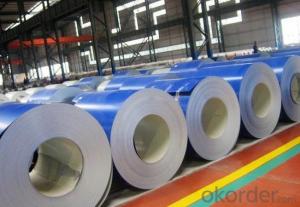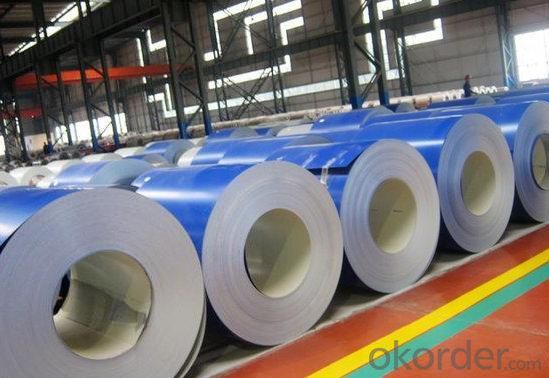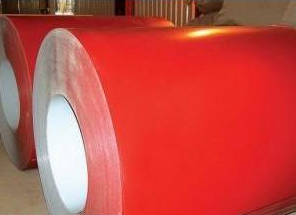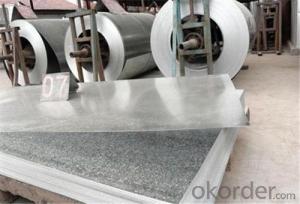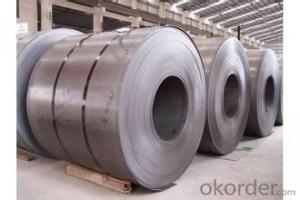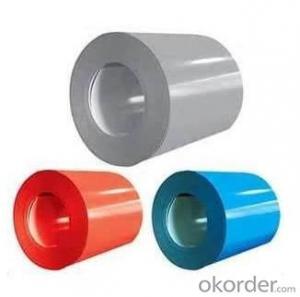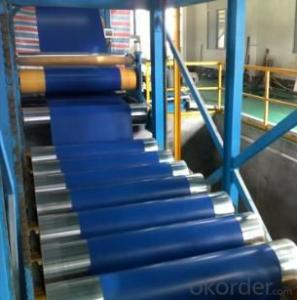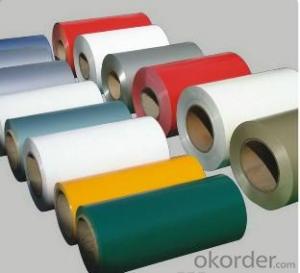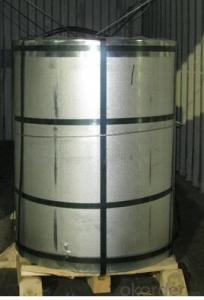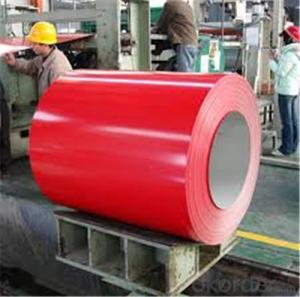Colored Coated Stainless Steel for Buliding Materials
- Loading Port:
- Shanghai
- Payment Terms:
- TT OR LC
- Min Order Qty:
- 25 m.t.
- Supply Capability:
- 8000 m.t./month
OKorder Service Pledge
OKorder Financial Service
You Might Also Like
Colored Coated Stainless Steel:
| Standard: | AISI,ASTM,GB,JIS |
| Thickness: | 0.25-0.8MM |
| Technique: | Cold Rolled |
| Surface Treatment: | Coated |
| Application: | Roofing |
| Special Use: | Silicon Steel |
| Width: | 800-1250MM |
| Color: | Ral or according to sample |
Packaging & Delivery
| Packaging Detail: | color steel coil STANDARD EXPORT SEAWORTHY PACKING |
| Delivery Detail: | 25 DAYS AFTER DOWN PAYMENT |
Specifications
color steel coil
Prime Quality, Quick Delivery, Competitive Price
Prepainted Galvanized Steel Coil (PPGI/PPGL)
Base material: Hot dipped galvanized steel
Width: available from 800MM to 1250MM
Width Tolerance: within 0.02MM
Thickness: available from 0.18MM to 0.80MM
Thickness Tolerance: within 0.15MM
Performance: Smooth or Matte
Color: according to RAL standard
Lacquer Coating thickness: according to customer needs
Supply capacity: 8,000 Metric Ton per month
Our products has good performance on combining force and anti-erosion. We offer fine quality products and best price for our international customers.
- Q: Can you recycle steel? And if you wanted to buy some recycled steel, where would you get it?
- Yes; steel can be recycled. Look on the Internet for dealers who sale recycled steel. Good luck! Smile!
- Q: What is the standard width of steel coils?
- The standard width of steel coils can vary depending on the specific industry and application. However, in general, the standard width for steel coils ranges between 36 inches to 72 inches. The specific width will depend on factors such as the type of steel being used, the intended use of the coils, and the equipment used for processing and handling the coils. It is important to consult industry standards and specifications to determine the appropriate width for a particular steel coil application.
- Q: How are steel coils used in the manufacturing of agricultural silos?
- Steel coils are used in the manufacturing of agricultural silos to create the cylindrical structure of the silo. These coils are rolled and shaped into large, seamless rings that form the walls of the silo. The coils provide strength and durability to withstand the weight of the stored grain or other agricultural products, ensuring the structural integrity of the silo.
- Q: Don't ask me why, but I took my stainless steel ring and I heated it up with my gas stove. I stuck it in there til the metal turned red, and the flame which is normally blue turned orange for some reason when the metal turned red. Anyway, afterwards i cooled it off in water and now it's all discolored and it feels different. It's weighs less and it doesn't feel the same. Plus, it's ugly cause it's all black and blue. What happened? Someone help
- You oxidized it. There is nothing you can do to recuperate the oxidized metal. The best you can do is to polish off the rust with a commercial metal polish paste.
- Q: Steel roofing info. Pros and cons on steel roofing?
- Steel roofing Pro...life of product is much longer then Asphalt shingles....Looks great...multi colors.......Just love the stuff... Cons....More costly then singles at first but since it last longer it is really a better buy.......
- Q: What are the different methods of perforating steel coils?
- There are several methods used for perforating steel coils, each with its own advantages and applications. 1. Mechanical Punching: This is one of the most common methods used for perforating steel coils. It involves using a mechanical press to punch holes in the coil using a punch and die set. The size and shape of the holes can be customized based on the design of the punch and die set. Mechanical punching is efficient and can produce high-quality holes with consistent results. 2. Laser Cutting: Laser cutting is a popular method used for perforating steel coils, especially when complex hole patterns or intricate designs are required. It involves using a high-powered laser beam to cut through the steel coil, creating precise and clean holes. Laser cutting offers flexibility in terms of hole size, shape, and spacing, and it can be computer-controlled for precise and repeatable results. 3. CNC Plasma Cutting: This method involves using a high-velocity plasma jet to cut through the steel coil and create perforations. CNC (Computer Numerical Control) technology is used to guide the plasma cutter, enabling precise and accurate hole patterns. CNC plasma cutting is ideal for thicker steel coils and can produce larger holes compared to laser cutting. 4. Waterjet Cutting: Waterjet cutting uses a high-pressure jet of water mixed with an abrasive material to cut through the steel coil. This method offers versatility in terms of hole size, shape, and material compatibility. Waterjet cutting is known for its ability to produce intricate and precise perforations without heat-affected zones or distortion. 5. Electrical Discharge Machining (EDM): EDM is a method that utilizes electrical discharges to erode the material and create perforations in the steel coil. It involves using a conductive electrode and a dielectric fluid to generate controlled sparks that remove material and form holes. EDM can be used to create complex shapes and patterns and is particularly suitable for hard materials. The choice of method depends on factors such as the desired hole size and shape, the thickness and type of the steel coil, the required precision, and the production volume. Each method has its own advantages and limitations, and it is important to select the most appropriate method based on the specific requirements of the perforated steel coils.
- Q: I am reading the book The Cure For All Advanced Cancers by Hulda Regehr Clark.She writes for example: cancer can be caused by exposure to heavy metals, like nickel and chromium from stainless steel cookware. Stainless steel cookware releases chromium and nickel, two of the most carcinogenic metals.Are there any studies done measuring how much nickel and cadmium can be released from the regular use of stainless steel cookware?Is this a commonly accepted opinion that use of stainless steel cookware is dangerous?If not stainless steel, what kind of cookware to use? I heard that non-stick cookware also releases some harmful chemicals.
- Hi, I think that Stainless Steel is one of the safest ways to cook food. Glassware is also safe, but you must be careful not to drop the stuff, it can break and leave small pieces on the floor. Yes non-stick cookware can harm small fast breathing animals like birds in your house if the cookware overheats, but by keeping water or moisture in the bottom of the pan, and not using supper high heat, you can avoid overheating a non-stick surface. This also includes not scraping the surface with the utensils. Aluminum cookware, especially cast aluminum is considered by many as more than average toxic to many. Test for alltimers is that they contain aluminum in their bodies, and many owned aluminum cookware too. To kill cancer, look to Dr. Otto Warburg, who did win a Noble Prize for discovering how to kill the cancer cells.
- Q: How are steel coils straightened?
- Steel coils are straightened using a process called leveling. This involves passing the coils through a series of rollers that gradually flatten and align the steel, resulting in straightened coils.
- Q: What are the different types of steel coatings for coil protection?
- There are several types of steel coatings for coil protection, including galvanized coatings, zinc coatings, aluminum coatings, and polymer coatings.
- Q: I want to know where cold formed steel framing is used, is every steel frame we see in a construction sites like houses, building and bridges cold formed steel frames? or hot formed steel framing?I also read that cold formed steel framing is used for floors, is the steel frame beneath the floor's concrete cover?Thank u very much!!
- Abeer: I'm a civil/structural engineer. Cold-formed (or rolled) steel framing is typically limited to facades, studs in lightly-loaded bearing walls and non-load bearing wall studs. Hot-rolled steel members are typically used to frame steel buildings and bridges. See the article below on cold-formed steel framing.
Send your message to us
Colored Coated Stainless Steel for Buliding Materials
- Loading Port:
- Shanghai
- Payment Terms:
- TT OR LC
- Min Order Qty:
- 25 m.t.
- Supply Capability:
- 8000 m.t./month
OKorder Service Pledge
OKorder Financial Service
Similar products
Hot products
Hot Searches
Related keywords
